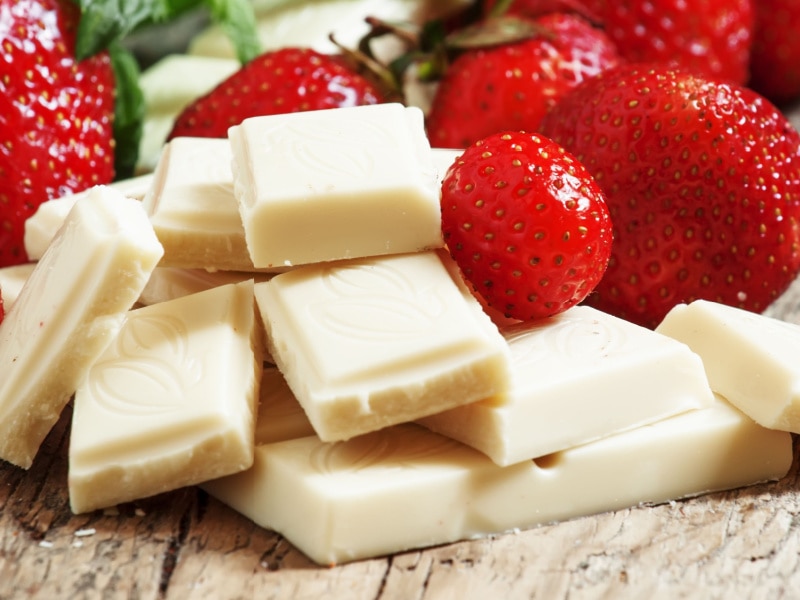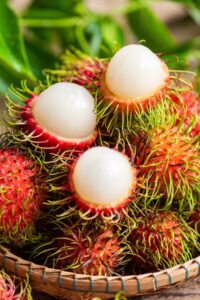If you’ve ever seen a cacao nib, you might wonder: what is white chocolate? Cacao is pretty dark, after all.
And while opinions differ, just know it definitely is chocolate (per the FDA) – it’s just a little different.

White chocolate is a blend of at least 20% cocoa butter, 3.5% milk fat, and 14% milk solids.
If it contains less than this, it’s not technically white chocolate and is, instead, usually labeled as a “white chocolate flavored product”.
Unlike milk or dark, white chocolate contains no chocolate liquor.
As much as people love it, there are still many questions surrounding what white chocolate actually is.
So, if you’re wondering the same thing, let’s explore together.
What Is White Chocolate?
White chocolate is a confection containing cocoa butter, sugar, and milk solids.
But since it doesn’t contain cocoa solids, many believe it does not meet the technical definition of chocolate.
However, most regulatory bodies worldwide recognize white chocolate as real chocolate.
Invented in the 1930s, white chocolate came about due to a surplus of milk powder.
Companies like Nestle had lots left over because WWI had recently ended, and they were no longer sending it to the troops.
Thus, white chocolate was born.
Though, at the time, it wasn’t legally considered chocolate. And in some places, it’s still not.

What Is White Chocolate Made Of?
White chocolate is made of cocoa butter, milk, and sugar.
It’s often flavored with vanilla and includes lecithin, an emulsifier.
White chocolate must contain at least 20% cocoa butter to be considered chocolate. Therefore, cheaper products that use vegetable fats are not regarded as real chocolate.
Believe it or not, white chocolate is made from the same thing as milk and dark chocolate.
In fact, they all come from some part of the cacao nib and use the same basic manufacturing process.
To understand this, let’s first look at how chocolate is made:
- Chocolate manufacturers harvest pods from the cacao tree.
- They crack open the pods and take out the beans.
- The beans are left out to ferment.
- They dry and roast the beans, removing and discarding the shells.
- This leaves them with cacao nib, which they grind into a thick paste.
This thick paste is known as chocolate liquor. The liquor is then broken down into two distinct ingredients. cocoa butter and cocoa solids.
This is the point where white chocolate diverges from milk and dark chocolate.
How White Chocolate Is Made
To make white chocolate, you need to start with the same basic process as making any chocolate.
That means picking, fermenting, drying, and grinding the cocoa beans.
From there, it’s a pretty simple process:
- Cocoa butter is separated from the cocoa solids and heated.
- Sugar and milk solids are added to the cocoa butter and blended until smooth. This is known as “conching”.
- Additional ingredients, such as vanilla, may be added for flavor.
- The chocolate is then cooled and molded into chips or bars.
Another additional ingredient often found in white chocolate is lecithin, a food additive used to help bind and emulsify the ingredients.
- High-quality white chocolate contains a lot of cocoa butter and typically calls for real vanilla for added sweetness.
- Low-quality white chocolate flavored products use little to no cocoa butter and call for synthetic flavorings.
Is White Chocolate Actually Chocolate?
People will always insist that white chocolate isn’t really chocolate. But the truth is simple:
Per the FDA ruling of 2002, white chocolate is actually chocolate as long as it contains “no less than 20 percent by weight of cacao fat,” at least 3.5% by weight of milk fat, and at least 14% by weight of milk solids.
The ruling was to encourage consistency in manufacturing and aid consumers.
Giving chocolate makers these standards made it easier to weed out cheaper products.
Therefore, consumers would be given the choice of higher-quality chocolate with fewer substitutions.
For example, some brands use vegetable oil instead of cocoa butter. In that case, it’s a white chocolate-flavored product and not actual white chocolate.

What Does White Chocolate Taste Like?
Want to know the biggest argument against white chocolate being chocolate? It’s that it doesn’t taste like chocolate.
And that’s actually true.
White chocolate tastes very rich and creamy. It has an entirely different flavor profile than milk or dark chocolate as it doesn’t contain cocoa solids.
Depending on the brand and ingredients, it can be more or less sweet and creamy. If it includes real vanilla, it will have a sweet warmth.
As a baker, I find it very easy to taste the difference between good white chocolate and cheap knock-offs. And mostly, that’s down to the texture.
Top-quality white chocolate with lots of cocoa butter is smooth and melts on your tongue.
Cheaper brands don’t melt the same and may even be grainy.
Think of it like comparing creamy vanilla Häagen-Dazs with the off-brand, economy stuff from Walmart. They’re worlds apart!

White Chocolate vs. Milk Chocolate (What’s the Difference?)
From the picture alone, it’s easy to tell these two sweet treats apart. But that’s not the only difference between white and milk chocolate:
Color
Milk chocolate is brown. It could be light or dark brown, but it’s uniformly brown.
White chocolate, on the other hand, is white or cream-colored.
Flavor
Milk chocolate has a distinct chocolatey flavor. It’s sweeter than dark chocolate but does have a slight bitterness when compared to white chocolate.
White chocolate, as mentioned, tastes sweet and buttery. It also contains hints of vanilla and cream.
Manufacturing
Of course, the most significant difference between white chocolate and milk chocolate is how they’re made.
Milk chocolate (and darker chocolates) require cocoa solids – at least 10% cocoa solids, to be specific.
White chocolate has no cocoa solids. Instead, it contains only cocoa butter.
(Milk chocolate also contains cocoa butter. But the cocoa solids make all the difference.)

How to Cook with White Chocolate
Like other types of chocolate, white chocolate is used mainly in desserts.
You can drop it in whole (i.e., white chocolate chips), melt it and add it to your recipe, or use it as a garnish.
You’ll find white chocolate in a myriad of desserts, including:
- Cookies
- Cakes
- Mousse
- Tarts
- Pancakes
- Sundaes
- Hot chocolate
- Coffee drinks
- Etc.
Basically, you can use it in anything you’d use milk or dark chocolate.
However, the key thing to remember is top-quality vs low-quality. If you use cheap white chocolate, it won’t melt as smoothly, and it may even burn.
Chips are especially prone to burning in cookies, for example, because they’re exposed to the heat of the oven.
And if you don’t have good-quality chocolate chips, they’ll turn brown and grainy instead of melty.

Where to Buy White Chocolate
You’ll find “white chocolate” practically anywhere chocolate is sold. That means bars, candies, and chips.
Unfortunately, finding real white chocolate can be trickier to source.
Always check the ingredients list on the package. It isn’t really white chocolate if you don’t see at least 20% cocoa butter on the list.
For the best white chocolate, small chocolatier shops are typically your best option. Though you can find good stuff online too!
If you bake a lot, try to source Couverture chocolate. Trust me, it makes all the difference!
White Chocolate Recipes You’ll Love
Easy White Chocolate Cheesecake
White Chocolate Fudge
Subway White Chocolate Macadamia Nut Cookies
Easy White Chocolate Bark










